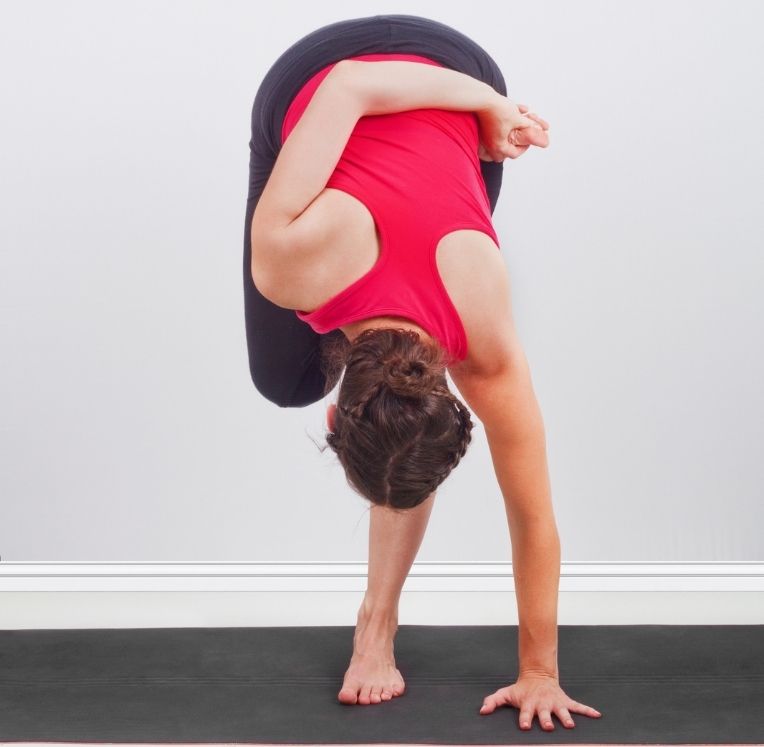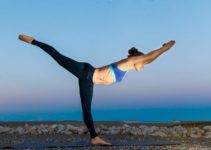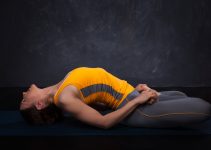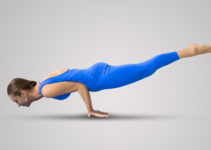
Ardha Baddha Padmottanasana is a standing yoga pose that combines two classical asanas Ardha Padmasana (Half Lotus Pose) and Uttanasana (Standing Forward Bend). In this pose, one leg is placed in a half-lotus position, and the corresponding hand reaches behind the back to hold the foot while the torso bends forward.
The English name Half Bound Lotus Standing Forward Bend is a direct translation of its Sanskrit name. It is also known as Standing Half Bound Lotus Pose.
This pose is a balancing forward bend that stretches the legs, hamstrings, hips, lower back, and neck. It also improves concentration and flexibility.
Since Ardha Baddha Padmottanasana involves balancing, forward bending, and a mild inversion at the same time, it can be quite challenging. It is generally considered an advanced-level yoga pose.
Meaning and interpretation
Ardha Baddha Padmottanasana is a Sanskrit name composed of six terms:
- Ardha – Half
- Baddha – Bound
- Padma – Lotus
- Ut – Intense
- Tan – Stretch
- Asana – Pose
Together, Ardha Baddha Padmottanasana translates to “Half Bound Lotus Intense Stretch Pose.” The name itself reflects the movements involved in this yoga posture.
In this pose:
- One leg is brought into Padmasana (lotus position) and held from behind with the same-side hand – representing the Ardha Baddha Padma aspect.
- The torso then folds forward over the standing leg from the hips – representing Padmottanasana or the intense forward stretch.
This asana challenges your balance, as it is performed while standing on one leg. It delivers a deep stretch to the hips, quadriceps, hamstrings, and calves, while also strengthening the legs, spine, and shoulders.
Because the head is placed below the heart, this pose also acts as a mild inversion and may help stimulate the crown chakra (Sahasrara), encouraging mental clarity and inner focus.
Ardha baddha padmottanasana practice guide

To do the ardha baddha padmottanasana, go through the following points below;
Precautions & contraindications
- Recent injury – Do not perform ardha baddha padmottanasana if you have an injured knee, hip, or shoulder. The pose involved intense stretches and any further pressure might cause severe effects on the injury.
- High blood pressure – Avoid the pose if you have high blood pressure as the heart is under extreme pressure in the forward bend.
- Glaucoma – The patients of glaucoma must avoid the Ardha baddha padmottanasana.
- Headache – The pose is not recommended to be performed with a heavy head especially in case of a migraine.
- Diarrhea – Never perform this asana with an upset stomach.
- Do not push the body beyond its potential. It is always better to increase the limits with time and practice.
- Perform it under expert’s guidance.
Preparatory poses
- Head-to-Knee Pose (Janu Sirsasana)
- One-Legged King Pigeon Pose (Eka Pada Rajakapotasana)
- Standing Forward Fold (Uttanasana)
How to do ardha baddha padmottanasana (steps)

- Begin with standing in tadasana.
- Inhale and lift your right leg balancing the bodyweight on the left leg.
- Hold the folded right foot with your left hand and externally rotate the right thigh.
- Tuck your right heel in the lower abdomen beside the navel
- Circle the right hand around your back and reach the right big toe.
- Exhale and bend forward at the hip level.
- Place your left hand on the floor beside the standing floor.
- Distribute the body weight equally between the left foot and left hand.
- Look forward to a point and take a deep breath in.
- Exhale and bring your head towards the knee touching he chin to the shin.
- Stay in the pose for 5-6 breaths.
- Inhale and look forward, stay there for a second.
- Exhale slowly lifting and stay there for two seconds.
- Release the right hand holding the right foot with the left hand.
- Unfold the right knee and bring it to the floor.
- Relax in tadasana. Repeat the same with the left foot.
Beginner’s tips
- To maintain the balance in Ardha Baddha Padmottanasana first initiate with tree pose and then project your lifted foot to the lower abdomen.
- Follow the modifications below to fight the flexibility issues.
- Do not push yourself to hold the big toe, you can start with grabbing the elbow by wrapping the alternative hand around the back.
Follow up poses
- Staff Pose (Dandasana)
- Chair Pose (Utkatasana)
- Warrior Pose 1 (Virabhadrasana I)
- Warrior Pose 2 (Virabhadrasana II)
Modifications and props
- Using a yoga strap – Wrap the lifted foot with a strap. Now, as you circle your hand around the back instead of grabbing the lifted toe you can hold the strap.
- Using a block – You can place a block beside your standing foot and as you lean forward you can rest your palm over it.
Variations
To go further in Ardha Baddha Padmottanasana, use these variations to deepen the pose.
- Perform the pose without wrapping one hand on the back to hold the big toe. As you bend forward place both the hands on the floor.
- Perform ardha baddha padmottanasana with the hands in the prayer pose. Here, the folded foot stays on the lower abdomen, hook it there with forward leaning. As you reach halfway join your palms and keep your spine parallel to the floor.
Ardha Baddha Padmottanasana Benefits
Ardha Baddha Padmottanasana offers a unique blend of balance, flexibility, and internal stimulation. By combining a deep forward bend with a half-lotus bind, it supports joint mobility, enhances digestion, and brings a quiet focus to the mind.
1. Improves flexibility
Ardha Baddha Padmottanasana is a deep stretching pose that targets the hips, hamstrings, ankles, shoulders, and arms. This intense stretch helps improve muscle flexibility and mobility.
2. Enhanced digestion
During the forward bend in Ardha Baddha Padmottanasana, the folded foot presses against the abdomen. This gentle pressure creates a contraction in the abdominal area, stimulating the digestive organs. As a result, it encourages the secretion of digestive juices and supports better digestion. Regular practice of this pose may also help relieve gastric issues and improve overall digestive health.
3. Facilitates respiration
Standing half bound lotus pose expands and opens up the chest when the hand holds the toe from behind. It helps in the expansion of respiratory organs and thereby improves the functioning of the respiratory system.
4. Increases concentration
While maintaining balance in the forward bend of Ardha Baddha Padmottanasana, the root chakra (Muladhara) is believed to be activated. Among students, regular practice of this pose has been associated with enhanced balance, focus, and concentration1. As a result, it also helps improve self-awareness and mental clarity.
5. Benefits sacral chakra
Since the abdominal cavity is engaged during Ardha Baddha Padmottanasana, the sacral chakra (Svadhisthana) is also stimulated. This activation supports emotional well-being and helps regulate the reproductive system, promoting overall hormonal balance.
6. Stimulates nervous system
During Ardha Baddha Padmottanasana, the head is gently surrendered to gravity. This enhances blood circulation to the brain, increasing the supply of oxygen to brain cells. As a result, it creates a calming and soothing effect on the nervous system, promoting mental clarity and relaxation.
Conclusion
No matter how intimidating Ardha Baddha Padmottanasana may appear, it offers a wide range of benefits that make it worth trying. Even beginners can experience its advantages by practising modified versions of the pose.
As a fusion of two powerful asanas, this pose deeply rejuvenates the body and mind, enhancing its overall appeal and effectiveness. With consistent practice, it becomes both rewarding and transformative.




